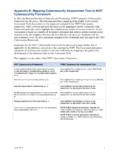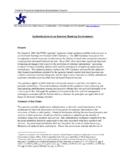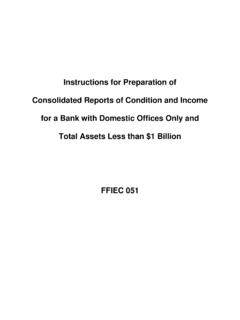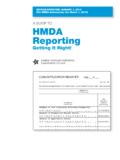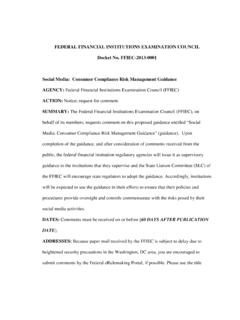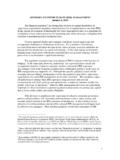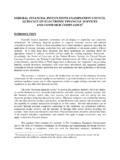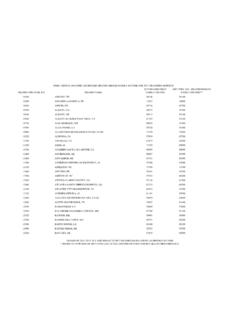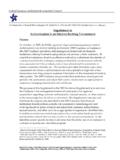Transcription of Federal Financial Institutions Examination Council
1 Federal Financial Institutions Examination Council October 2016 1 FFIEC Cybersecurity assessment Tool frequently asked Questions October 17, 2016 Purpose The Federal Financial Institutions Examination Council (FFIEC)1 members have received several requests to clarify points in the 2015 FFIEC Cybersecurity assessment Tool ( assessment ) and supporting materials. This document provides answers to f requently asked questions. frequently asked Questions 1. Why did the FFIEC release the assessment ? Financial Institutions and their service providers are increasingly dependent on information technology (IT) and telecommunications to deliver services to consumers and businesses every day. Disruption, degradation, or unauthorized alteration of information and systems that support these services can affect operations, Institutions , and their core processes, and undermine confidence in the nation s Financial services sector. Cyber attacks have increased in frequency and severity with recent attacks involving extortion, destructive malware, and compromised credentials.
2 Management of Financial Institutions and management of third-party service providers are primarily responsible for assessing and mitigating their entities cybersecurity risk. FFIEC members developed the assessment to help Institutions management identify their risks and determine their cybersecurity preparedness. The assessment provides a repeatable and measurable process that Financial Institutions management may use to measure their cybersecurity preparedness over time. 2. Does my institution have to use the assessment ? No. Use of the assessment by Institutions is voluntary. Institution management may choose to use the assessment , or another framework, or another risk assessment process to identify inherent risk and cybersecurity preparedness. The FFIEC released the assessment as a voluntary tool that institution management may use to determine the institution s inherent risk and cybersecurity preparedness. 1 The Council consists of the following six voting members: a member of the Board of Governors of the Federal Reserve System; the Chairman of the Federal Deposit Insurance Corporation; the Director of the Consumer Financial Protection Bureau; the Comptroller of the Currency; the Chairman of the National Credit Union Administration; and the Chairman of the State Liaison Committee.
3 Federal Financial Institutions Examination Council October 2016 2 3. What is the value of the assessment to management? By using the assessment , management will be able to enhance its oversight and management of the institution s cybersecurity by doing the following: Identifying factors contributing to and determining the institution s overall cyber risk. Assessing the institution s cybersecurity preparedness. Evaluating whether the institution s cybersecurity preparedness is aligned with its inherent risks. Determining risk management practices and controls that are needed or require enhancement and actions to be taken to achieve the desired state. Informing risk management strategies. 4. How does the assessment align with the NIST Cybersecurity Framework? The FFIEC Information Technology Examination Handbook (IT Handbook), the National Institute of Standards and Technology (NIST) Cybersecurity Framework, and industry-accepted cybersecurity practices were used in the development of the assessment .
4 A mapping of the NIST Cybersecurity Framework to the assessment is included as Appendix B of the assessment . NIST reviewed and provided input on the mapping to ensure consistency with NIST Cybersecurity Framework principles and to highlight the complementary nature of the two resources. 5. Will the FFIEC release an automated version of the assessment ? The FFIEC does not intend to release an automated version of the assessment at this time. FFIEC members are aware of a number of automated versions of the assessment developed by Financial Institutions and industry groups. For example, the Financial Services Sector Coordinating Council (FSSCC) working in conjunction with the Financial Services Information Sharing and Analysis Center (FS-ISAC) and trade associations developed an automated 6. In using the assessment , how do I determine my institution s Inherent Risk Profile?3 In completing the assessment , management may determine the institution s overall Inherent Risk Profile based on the number of applicable statements in each risk level for all activities, products, and services.
5 For example, when a majority of activities, products, or services fall within the Moderate Risk Level, management may determine that the institution has a 2 Available at Although the automated versions of the assessment are not established or endorsed by FFIEC members, they may help Financial Institutions complete the assessment . 3 Inherent Risk Profile refers to part one of the assessment and is used to identify the institution s inherent risk. Federal Financial Institutions Examination Council October 2016 3 Moderate Inherent Risk Profile. Each category may, however, pose a different level of inherent risk. Therefore, in addition to evaluating the number of times an institution selects a specific risk level, management may also consider evaluating whether the specific category poses additional risk that should be factored into the overall assessment of inherent risk.
6 7. In using the assessment , how do I determine my institution s Cybersecurity Maturity?4 Management may determine the institution s maturity level within each of the five domains: Domain 1: Cyber Risk Management and Oversight Domain 2: Threat Intelligence and Collaboration Domain 3: Cybersecurity Controls Domain 4: External Dependency Management Domain 5: Cyber Incident Management and Resilience Each maturity level includes a set of declarative statements that describe how the behaviors, practices, and processes of an institution can consistently produce the desired outcomes. Management determines the declarative statements that best fit the current practices of the institution. All declarative statements in each maturity level, and previous levels, must be attained and sustained to achieve that domain s maturity level. While management can determine the institution s maturity level in each domain, the assessment is not designed to identify an overall cybersecurity maturity level.
7 8. How should the Inherent Risk Profile align with Cybersecurity Maturity? While there are no expected maturity levels for an institution, Inherent Risk levels should be balanced with maturity. If management determines that the institution s maturity levels are not appropriate in relation to the Inherent Risk Profile, management should consider reducing inherent risk or developing a strategy to improve their levels of maturity. Management may choose to evaluate the institution s inherent risk overall, as well as inherent risk for specific activities, services, or products. In general, when the inherent risk of an activity, service, or product rises the maturity level of related controls and risk mitigation activities should increase, as well. 4 Cybersecurity Maturity refers to part two of the assessment and is used to identify the institution s maturity level within each of the five domains.
8 Federal Financial Institutions Examination Council October 2016 4 9. How do I account for compensating controls or partial implementation of a declarative statement? As the assessment is voluntary, management may choose to customize the assessment for its institution s needs. Customization may include identifying various methods for accounting for compensating controls or other means for attaining a declarative statement. 10. Can the assessment be used as part of my institution s oversight of third parties? Yes. As the assessment is voluntary, management may choose to use it as a resource for the oversight of third parties as part of the institution s comprehensive third-party management program. 11. In completing the assessment , how do I account for controls implemented by my institution s third-party service providers? Management may consider declarative statements in all domains that are attained by a third-party service provider on behalf of the institution.
9 Domain 4: External Dependency Management provides a structure for management to evaluate the institution s oversight of third-party service providers. Management is responsible for the assessment of the risk associated with the nature, extent and complexity of its institution s third-party relationships. Such assessment includes evaluating the extent to which controls put in place by the institution's third-party service providers could be considered in the institution's mitigation of its overall cybersecurity risk, including the cybersecurity risk associated with its use of third-party service providers. 12. How are the FFIEC members using the assessment ? To obtain additional information about a particular FFIEC member s use of the assessment , Financial institution management should contact its institution s regulator directly. Management of Financial Institutions and management of third-party service providers are primarily responsible for assessing and mitigating their entities cybersecurity risk.
10 FFIEC members developed the assessment to help Institutions management identify their risks and determine their cybersecurity preparedness. 13. Where can I find more information on the assessment ? The FFIEC Cybersecurity assessment Tool web page5 includes the assessment as well as the following supplemental materials: 5 Federal Financial Institutions Examination Council October 2016 5 Overview for Chief Executive Officers and Boards of Directors User s Guide Appendix A: Mapping Baseline Statements to the FFIEC IT Handbook Appendix B: Mapping to NIST Cybersecurity Framework Appendix C: Glossary In addition, management may contact its institution s regulator. 14. How can a community institution meet baseline declarative statements? The assessment was designed to help institution management identify its institution s inherent risks and determine its institution s cybersecurity maturity.
